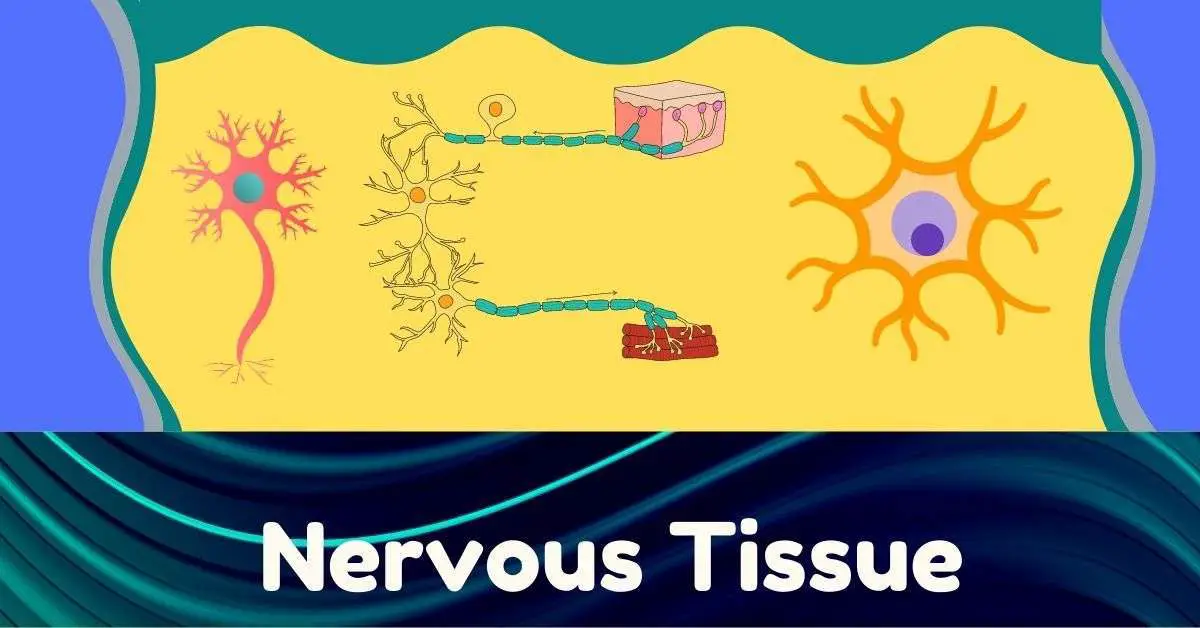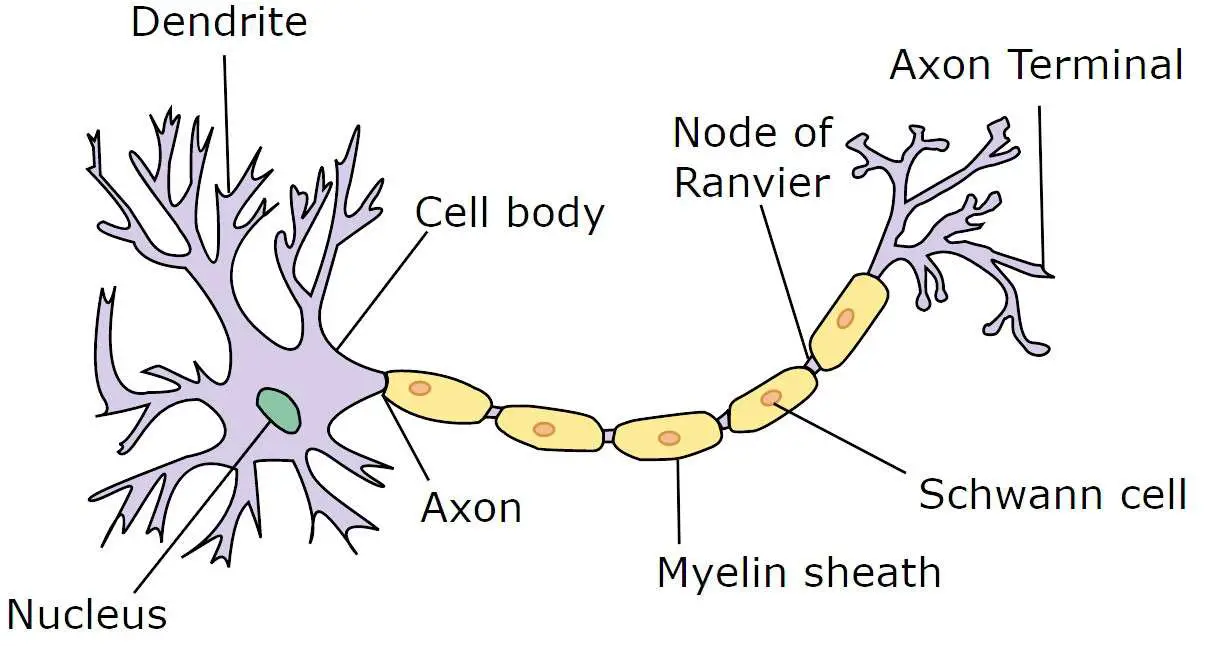Nervous tissue is also known as neural tissue. It is the prime component of nervous system which controls and regulates activity and bodily functions. It is composed of two parts: (1) Central Nervous System or CNS and (2) Peripheral Nervous System or PNS. In this case, CNS comprises the spinal cord and brain while PNS comprises the branching peripheral nerves. Muscle contraction is stimulated by the nervous system. It makes a consciousness of the environment. It also plays an important role in emotions, memory and reasoning.
Nervous tissues responsible for adjustment of body in response to either external or internal environmental changes. It is located in the brain, spinal cord and nerves. The nervous tissue is highly specialized epithelial tissue for reception, discharge and transmission of stimuli. It is composed of two types of cells: neuron (the nerve cells) and neuroglia (accessory cells).
1. Neuron or Nerve Cells: The structural and functional unit of nervous system is known as neuron or nerve cell.
Classification of Neuron: Neurons may be classified as follows: 1. According to function-Neurons may be of the following three types:
(i) Afferent (sensory) neuron (ii) Efferent (motor) neuron and (iii) Internuncial (intercalated) neuron.
According to structure: Depending on the length of axons, the neurons are of two types (i) Golgi I neurons and (ii) Golgi II neurons.
According to poles: According to number of axon and dendrites from the cell body the neurons are as follows:
(i) Apolar neuron: When there is no axon or dendrite are present but contain but contain only cell body, it is called apolar neuron.
(ii) Unipolar neuron: When one axon and one dendrite combined and originates from one pole of the cell body, the neuron is known as unipolar neuron.
(iii) Bipolar neuron: In this type of neuron, one axon and one dendrite originate from opposite poles of the cell body.
(vi) Multipolpolar neuron: In this type many dendrites and one axon arise from several parts (poles) of the cell body.
Structure of Neuron
Neuron consists of two parts such as (A) cell body and (B) processes.
(A) Cell body: The cell is often called cyton or centron or parikaryon. A typical cell body may rounded or polygonal or spindle shaped or flask-shaped or pyramidal shaped. The surface of the cell body is covered by fine plasma membrane
The cytoplasmic matrix of the nerve cell is known as neuroplasm. It contains a spherical nucleus with a large nucleolus. Special bodies called Nissl granules, a network of fine ultramicroscopic fibrils the neurofibrils, Golgi apparatus, ribosome, endoplasmic reticulum, centrosome, etc. are present in the neuroplasm. The cell body is present in the ganglia and central nervous system i.e., in the grey matter of the brain and spinal cord. It regulates the functional activities of the neuron (nerve cell).
Fig. Showing Nerve cells (Neuron) and different parts
(B) Processes: The cell body of the neuron give rise several branching processes which are of two types such as: (i) axon and (ii) dendrite.
(i) Axon: There is usually a long branch known as axon. It arises from a special protruberance on the cell body known as the hillock. The axon is generelly called the nerve fibre. The cytoplasm of the axon known as axoplasm which is covered by a fine plasma membrane known as axolemma. The axon is branched at its distal end known as axon terminals which make contact with other neuron to form synapase or with muscle to form neuromuscular junction
(ii) Dendrites (Dendrons): Besides the axon there are one or more shorter branched processes called dendrites. The dendrites serve to carry messages to the nerve cell.
Myelinated and Non-myelinated Nerve Fibre
The axons, both in the vertebrates and invertebrates, are often covered with a sheath called the myelin sheath such fibres (axons) are called myelinated (medullated) fibre, while those which are not covered are called non-myelinated (non medullated) fibre. Dendrites are always non-2myelinated.
Myelinated Fibre: It is composed of three elements-axis cylinder, myelin sheath (medullary sheath) and neurolemma (neuroliemma). The axis cylinder (axon) is the innermost part covered by the thin membrane axolemma and filled up with axoplasm. Surrounding the axon is myelin sheath that is approximately as thick as the axon itself. The myelin sheath provides both mechanical support and electrical insulation to the axon. The myelin sheath is broken at regular intervals along the length of the axon. The place where the myelin sheath is discontinuous are called Nodes of Ranvier. All nerve fibres outside the central nervous system, receive another homogeneous nucleated continuous covering–the neurolemma (sheath Schwann). The neurolemma protects the nerve fibre, supply nutrition and helps in the repairing of damaged peripheral nerves.
Non-myelinated Fibre: This type of nerve fibre do not contain myelin sheath but only axon cylinder and neurolemma are present. Hence the diameter of this nerve is less than myelinated fibre.
Nerves: A single nerve is composed of bundle of several axons The individual axon is covered by neurolemma. The connective tissue layer surrounding the individual axon is called endoneurium. Several axons are bounded together by another connective tissue sheath called perineurium. Several such bundles of axons are combined together by another connective tissue layer called epineurium to form a nerve.
Neuroglia: It is special type of nerve tissue present in between the neurons. Neuroglia are three types such as (a) astrocytes, (b) oligodendrocytes (c) microglia. Its functions are(i) support (ii) insulation and (iii) phagocytes.
Table: Comparison between Axon and Dendrite
|
Axon |
Dendrite |
|---|---|
|
It is usually long and single process of neuron. |
It is usually short and multiple process of neuron. |
|
It has uniform thickness and unbranched. |
It is branched and tapper at the end. |
|
It is myelinated. |
It is non-myelinated. |
|
Neurolemma is present. |
Neurolemma is absent. |
|
Myelin sheath is differentiated into nodes and internodes. |
Nodes and internodes are not differentiated. |
| Structurally differ from the cell. |
Structurally same as cell. |
|
The external appearance is smooth. |
The external appearance is rough. |
|
It conducts impulse away from the cell body. |
It conducts impulse to the cell body. |


